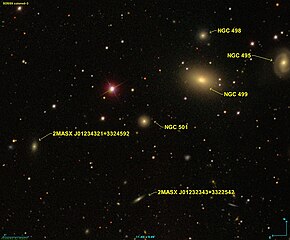NGC 501
| NGC 501 | |
|---|---|
 SDSS view of NGC 501 | |
| Observation data (J2000[1] epoch) | |
| Constellation | Pisces[2] |
| Right ascension | 01h 23m 22.4s[3] |
| Declination | +33° 25′ 59″[3] |
| Redshift | 0.016561 ± 0.000227[1] |
| Heliocentric radial velocity | (4924 ± 68) km/s[1] |
| Distance | 224 Mly[4] |
| Apparent magnitude (V) | 14.5[2] |
| Apparent magnitude (B) | 15.5[2] |
| Characteristics | |
| Type | E0[2] |
| Apparent size (V) | 0.5' × 0.5'[2] |
| Other designations | |
| PGC 5082, GC 284, 2MASS J01232240+3325582 [1][5] | |
NGC 501, also occasionally referred to as PGC 5082 or GC 284, is an elliptical galaxy in the constellation Pisces.[2] It located approximately 224 million light-years from the Solar System[4] and was discovered on 28 October, 1856 by Irish astronomer R. J. Mitchell.[5]
Observation history
Although John Dreyer, creator of the New General Catalogue, credits the discovery to astronomer William Parsons, 3rd Earl of Rosse, he notes that many of his claimed discoveries were made by one of his assistants. In the case of NGC 501, the discovery was made by R. J. Mitchell,[5] who discovered it using Lord Rosse's 72" reflecting telescope at Birr Castle in County Offaly, Ireland.[6] The object was described "very faint, small (E in Birr diagram)" in the New General Catalogue.[5]
See also
References
- ^ a b c d "NGC 501". Retrieved 2017-12-09.
- ^ a b c d e f "Revised NGC Data for NGC 501". spider.seds.org. Retrieved 2017-10-05.
- ^ a b "Your NED Search Results". ned.ipac.caltech.edu. Retrieved 2017-10-05.
- ^ a b An object's distance from Earth can be determined using Hubble's law: v=Ho is Hubble's constant (70±5 (km/s)/Mpc). The relative uncertainty Δd/d divided by the distance is equal to the sum of the relative uncertainties of the velocity and v=Ho
- ^ a b c d "New General Catalog Objects: NGC 500 - 549". cseligman.com. Retrieved 2017-10-16.
- ^ "Photos". www.klima-luft.de. Retrieved 2017-12-09.
External links
- NGC 501 on WikiSky: DSS2, SDSS, GALEX, IRAS, Hydrogen α, X-Ray, Astrophoto, Sky Map, Articles and images
- SEDS
